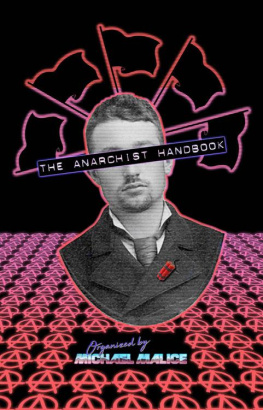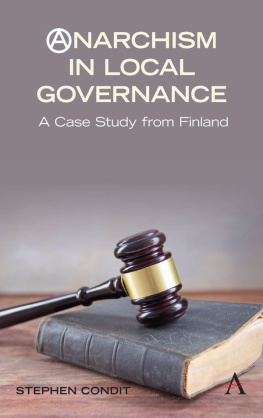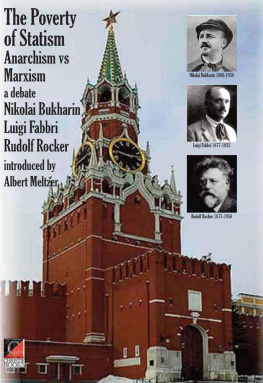Acknowledgments
A work of this nature owes its development to the generous and supportive efforts of many. I want to thank all of the anarchists, rank-and-file workers and community organizers with whom I have worked, shared, and discussed ideas and issues over the years. I would particularly like to thank P.J. Lilley for ongoing conversations and debates. A special thank you must go to Natalja Mortensen of Ashgate for her vision, support, and assistance, and her informative and communicative approach. My greatest thank yous go to Saoirse and Molly Shantz, my wonderful and loving best pals. Time to work is an amazing gift. This book is dedicated to them. Finally, thank you to all who are building the infrastructures of resistance every day in myriad ways.
Chapter 1
Organizing Anarchy: Debates and Directions
The bourgeoisie may blast and ruin their own world before they leave the stage of history. But we carry a new world in our hearts.
(Buenaventura Durruti)
We must act as if the future is today.
(Howard J. Ehrlich)
When contemplating the politics of tomorrow, as the last decade of the twentieth century approached, little thought was being devoted to the place of anarchism as a harbinger of the future world, outside of relatively small anarchist circles themselves. As anarchist chronicler Peter Marshall (1993, 661) suggested in the early 1990s: From Marx and Engels, who attacked all forms of unscientific socialism as utopian, onwards, anarchism has been dismissed as chimerical and fancifulat best a romantic dream, at worst a dangerous fantasy. Noted historian Eric Hobsbawm characterized anarchism both as a primitive rebellion and as the death sigh of the historically condemned. In rather patronizing terms, Alexander Gray scolded anarchists for being a race of highly intelligent and imaginative children, who nevertheless can scarcely be trusted to look after themselves outside the nursery pen (Marshall 1993, 661). Similarly, Marxists have long dismissed anarchism as little more than an infantile disorder (Lenin) or worse as mere banditry (George Plekhanov). Such negative depictions have served to cement anarchisms reputation among political commentators as a case of arrested development, a remnant of the past, to be outgrown, rather than a glimpse of the future new world. Some critics, trying to be a bit more generous, have seen in anarchism simply a cry of pain for the future, (Apter 1972, 1). In this case, anarchism is presented, mistakenly, as merely another variant of utopianism, a nice idea with little chance of realizing making its lofty aspirations. Anarchism, in such depictions, stands in relation to the future as nostalgia stands to the pastas little more than a comforting dream of a better world. The tendency to associate anarchism with outmoded ideas, in an evolutionary schema of political development, is not limited to analyses of classical anarchism. Even commentators addressing more recent manifestations of anarchy insist that, despite its enhanced philosophical sophistication, anarchism remains a primitive doctrine (Apter 1972, 1). Anarchism, it is said, is a movement of the past, out of touch with the realities of twenty-first century hypercapitalismcertainly not a movement of the future or for the future.
Perhaps none of this is too surprising. As Beth Hartung (1983) notes, any suggestion that the state and other forms of imposed authority might be replaced by a decentralized network or federation, as contemporary anarchists propose, is likely to be met with a sustained and vocal opposition. This is especially likely given that those who find current systems of imposed authority much to their liking are often those with the resources to mobilize public opinion in support of their preferences. There is certainly no doubt the opposition to the state and other systems of imposed authority undermines the dominant mode of political organization and the number of vested interests within it (Hartung 1983, 83). Thus the mighty force of resources, both material and ideological, that have been mobilized to condemn and discredit the beast of anarchy.
Social or political theories that suggest possibilities for social transformation are almost certain to be set upon quickly with claims that it is merely an expression of idealism or naivete. Partly this charge relates to the extreme difficulty the modern mind, ensconced in statist social structures and ideologies, has in envisioning a society held together without the cement of government in the form of the state. The accumulated experiences, histories and mythologies of centuries of nation-state hegemony make it difficult to even imagine anything that suggests alternative or means of arranging society. So ingrained is the worldview of nation-states that many conflate the notion of society with the notions of state or nation-state. For anarchists, rather than being similes or course, society and state are counter-posed or even oppositional notions. At the same time there is tendency to avoid the fact that in each modern case in which people have worked to produce stateless societies on a larger scale, they have been met by extreme military violence from the representatives of states or nation-states. Such dismissals and refusals to grapple with anarchism mean that the diversity of actual anarchist practices are little understood and the lively debates over questions of organization within anarchist movements have been silenced.
At the same time, the story of anarchism in the twentieth century appeared to give some credibility to the popular assessments of the prospects for anarchy. Anarchist political movements, so vibrant to begin the the new century, already seemed exhausted by its fourth decade. The mass suppression of North American anarchism and syndicalism during the Red Scare of the 1910s, the violent suppression of anarchism by the Bolshevik regime its early years of institutionalization in Russia and especially the brutal defeat of anarchosyndicalism during the Spanish Revolution seemed to signal the end of the line for the primitive revolutionaries of anarchism. By the early 1960s three prominent histories of anarchism concluded that anarchism had no future.
Clearly the reports of anarchys demise have proven to be stunningly premature. Since the 1990s anarchism has enjoyed a rather remarkable revival. Indeed, as many commentators (Epstein 2002; Day 2005) note that anarchism, more than any other specific political perspective animates the newest social movements of the alternative globalization movements. Certainly, in terms of the radical currents within alternative globalization movements it is anarchism, rather than socialism or Marxism that provides the imaginal force and visions that animate movements
At the same time the shape and form of contemporary anarchist practice has led some critics, including critics from within anarchist movements themselves, to believe that the prognosis for contemporary anarchy is not much more encouraging than the histories of the earlier movements. Much of anarchist activity in North America is still characterized by this description from the anarchist communist Dielo Trouda group in 1926: local organizations advocating contradictory theories and practices, having no perspectives for the future, nor of a continuity in militant work, and habitually disappearing, hardly leaving the slightest trace behind them. Many of these short lived projects are based on the synthesist modela loose assemblage of disparate ideas and practices under a general anarchist bannerof which anarchist communists have generally been wary. Such groupings work relatively well if the task remains at the level of running a book fair or community garden (both worthy projects in themselves). Yet, the absence of durable anarchist organizations, rooted in working-class organizations and communities, still contributes to demoralization or a retreat into subculturalism. Indeed, there have been explicit arguments among anarchists that attention should be given predominantly or even exclusively to building anarchist alternatives untainted by immersion in mainstream society rather than engaging within existing institutions such as unions or tenant organizations. In one recent article that received a good deal of attention within anarchist circles, an anarchist author explicitly dismisses issues of class and union organizing as old movement issues best left to Marxists and other socialists (see Jeppesen 2004).









